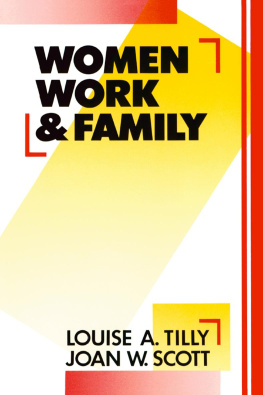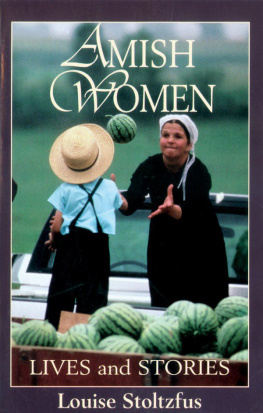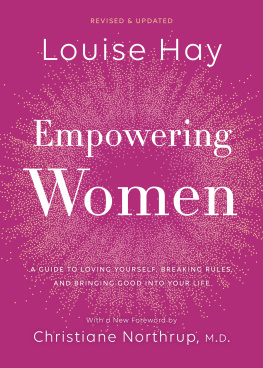Reprinted in 1989 by
Routledge, an imprint of
Routledge, Chapman and Hall, Inc.
711 Third Avenue
New York, NY 10017
Published in Great Britain by
Routledge
2 Park Square, Milton Park
Abingdon, Oxon OX14 4RN
1978 Holt, Rinehart and Winston; 1987 Louise A. Tilly and Joan W. Scott
First edition published in 1978 by Holt, Rinehart and Winston
All rights reserved. No part of this book may be reprinted or reproduced or utilized in any form or by any electronic, mechanical or other means, now known or hereafter invented, including photocopying and recording, or in any information storage or retrieval system, without permission in writing from the publishers.
Library of Congress Cataloging-in-Publication Data
Tilly, Louise.
Women, work, and family.
Originally published: New York: Holt, Rinehart and
Winston, 1978.
Bibliography: p.
Includes index.
1. WomenEmploymentGreat BritainHistory. 2. WomenEmploymentFranceHistory. 3. Work and familyGreat BritainHistory. 4. Work and family FranceHistory. I. Scott, Joan Wallach. II. Title.
HD6135.T54 1987 305.4'3'00941 87-11103
ISBN 0-415-90262-2
British Library Cataloguing in Publication Data
Tilly, Louise A.
Women, work and family.
1. WomenEnglandEconomic
conditions 2. WomenFrance
Economic conditions
I. Title II. Scott, Joan W.
330.942'008804 HQ1381
ISBN 0-415-90262-2
Introduction to the New Edition
We began work on this book in 1975. Trained as social historians, we had written dissertations on industrialization and working class politics in an Italian and a French city. In the early 1970s we each had been asked by our respective departments to develop a course in women's history. These courses were a direct response to the feminist movement's demands for an end to the invisibility and marginality of women not only in the institutions of contemporary American society, but in the academic curriculum as well. Feminist activists pointed out an important connection between the transmission of knowledge in university courses and the status of women in society. If women were absent from lists of important authors in courses on the literature of Western Civilization, if they never appeared as actors in the stories of important events in human history, if their experience was neglected in the formulation of theories of human moral development, the obvious conclusion for studentsmale and femalewas that women were insignificant as objects of study because they were somehow lesser in ability, achievement, and potential than were men. This lesson had the effect of perpetuating ideas about women that feminists were in the process of challenging. The challenge had many aspects: political and legal action through professional societies, trade unions, and feminist groups such as NOW and WEALto press for the inclusion of women in jobs, careers, and public organizations that had been closed to them; consciousness raising to produce among women themselves critiques of their subordinate positions and efforts to change them; and academic and curricular projects (for universities and high schools) in the form of both individual courses (in women's history or literature, for example) and entire interdisciplinary programs in women's studies. There was, and still is, no easy victory for any of these efforts, but feminists did succeed in gaining important ground, perhaps most notably within academia. Women's studies courses developed from initial improvisations by faculty or students; in many institutions they have now become part of regular offerings.
We began our collaboration in discussions about how to design our women's history courses. We found we shared a number of common ideas, particularly about how to study issues related to women and work. Not only did the subject of economic change and work experiences fit with our previous research, it also spoke to a dominant theme in the contemporary women's movement. Much of the theorizing of the early 1970s stressed the relationship between work for wages and improvements in women's status; work (usually undefined, but by implication paid labor) was offered as the solution to the oppressive confinement of domesticity and to the dependent situation of women in families. We thought this was too simple a correlation, for it ignored the complexities of social and economic history; wages alone, after all, had not historically conferred autonomy or higher status on all male workers. The link between wages and liberation for women also seemed to be associated with the idea that self-determination was possible in the labor market but not in the family, that the family represented the hold of tradition while the labor market held out the promise of modernity, that one left family ties behind when one took a job. To us, those oppositions between family and work, tradition and modernity, dependency and autonomy, women and men seemed overdrawn. The history of work, as we had studied it, involved interconnections of those factors rather than strict oppositions between them.
We wrote Women, Work and Family to address two agendas: debates among feminists about women and work, and debates among social historians about social and economic change. We wanted to know whether work improved women's position or changed their family roles and what the effect was on women of the dramatic changes associated with the industrial revolution.
Our inquiry produced a complex story of national, regional, and local variation. Women's employment opportunities depended, in part, on the rate and character of economic development, and these differed significantly in England and France. As a result, far more women were employed in agricultural work in France than in England, while English women more often became domestic servants than their French counterparts in the course of the nineteenth century. Within each country, however, there were important regional and local similarities. French and English coal mining towns resembled one another and differed from textile towns and commercial centers in terms of the composition of the workforce, demographic characteristics, and family and household organization. Our detailed investigation identified the importance of considering the interplay of economic and demographic variables in the shaping of women's job opportunities and family positions in any given context. It also led us to some general characterizations about women and industrialization, some answers to the initial questions we had posed.
Stated simply, the answers we offer are that wage work in itself represented a change but not an improvement in women's social position and did not dramatically alter the relationship of womenas daughters, wives, and mothersto their families. This was true despite the fact that industrialization created new wage-earning opportunities away from the household for women. Wages themselves, however, did not constitute liberation. For one, women's entry into wage labor markets often represented a family strategy, a way for a woman to fulfill what customarily had been considered part of her family responsibility. Yet another important characteristic of women's occupations was that they were sex-typed. From the pre-industrial period to the present, jobs have been segregated by sex, and women's work has persistently been associated with low skill and low pay. Sex-segregated labor markets are not simply differentiated markets, they are also asymmetrical: women's work is consistently ranked lower than men's. The dramatic appearance of women in factories in the early nineteenth century and their entry into offices in the early twentieth century did not fundamentally transform the social and economic designations of women as different, separate, and usually inferior workers in comparison to men. Neither did the fact of wage earning automatically bring new roles for women as family members. Instead, women's childbearing capability (whether they were married or not, or ever had children) seems to have affected the meanings attributed to their work by employers, parents, state officials, and themselves. However different these meanings were in the different time periods we studied, they had the similar effect of representing women workers as an exception to the general category of the (male) worker. The fact that women were seen to play at least two rolesthe biological and the economicrendered them less valuable as workers, less well paid and hence more dependent on family support. Family relationships responded to the asymmetry of the labor market and, at the same time, reproduced the arrangements upon which the asymmetry was based. Women, work, and family were thus inseparable categories, defining one another and creating relationships of interdependence. Together the three terms seemed to us to offer important insight into the history of women's work.










